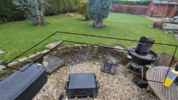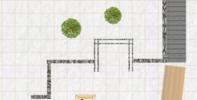- Joined
- 27 Nov 2021
- Messages
- 13
- Reaction score
- 0
- Country

Afternoon all
So I decided (with the wifes' approval of course) to build my own outdoor kitchen.
Since we moved in I ripped out a load of overgrown bushes against the old (kinda) retaining wall that edges the 2 tiers of our garden. It curves a lot and is frankly pretty messy.
I use this space to house the BBQs, some equipment etc and honestly I've always wanted an outdoor spot to grill.
I'm still in planning mode but I have like 2.5m x 2.5 to play with and intend to make a |_| shape, it'll house some units from somewhere https://uk.vevor.com/outdoor-kitchen-door-c_10622, a sink, patio tiles as a floor etc. I will have to redo chunks of the wall to get the run to the nearest sewage pipe so I'm thinking it's time to fix all the breaks in it, repoint or even just rip it down and start again as it's an absolute mess in most places.
My biggest issue with what to do though is the carving into the existing garden.
Taking the wall out, and rebuilding it is easy enough...but what do I do about the water that runs through it all now. When it's hammering it down you can see the water leaking out of the existing walls.
If I just build a set of stone or wood cabinets into the mud, I'm going to clearly have a water issue where everything inside will end up covered in mould/wet all the time.
I think I might need to build a french drain round the side of the wall. Build a retaining wall in something like dense blocks, then a waterproof membrane and then build my kitchen on the other side of it?
I'm not even sure of exactly what I need to google/youtube to learn either so here I am looking for advice!
Thanks in advance
So I decided (with the wifes' approval of course) to build my own outdoor kitchen.
Since we moved in I ripped out a load of overgrown bushes against the old (kinda) retaining wall that edges the 2 tiers of our garden. It curves a lot and is frankly pretty messy.
I use this space to house the BBQs, some equipment etc and honestly I've always wanted an outdoor spot to grill.
I'm still in planning mode but I have like 2.5m x 2.5 to play with and intend to make a |_| shape, it'll house some units from somewhere https://uk.vevor.com/outdoor-kitchen-door-c_10622, a sink, patio tiles as a floor etc. I will have to redo chunks of the wall to get the run to the nearest sewage pipe so I'm thinking it's time to fix all the breaks in it, repoint or even just rip it down and start again as it's an absolute mess in most places.
My biggest issue with what to do though is the carving into the existing garden.
Taking the wall out, and rebuilding it is easy enough...but what do I do about the water that runs through it all now. When it's hammering it down you can see the water leaking out of the existing walls.
If I just build a set of stone or wood cabinets into the mud, I'm going to clearly have a water issue where everything inside will end up covered in mould/wet all the time.
I think I might need to build a french drain round the side of the wall. Build a retaining wall in something like dense blocks, then a waterproof membrane and then build my kitchen on the other side of it?
I'm not even sure of exactly what I need to google/youtube to learn either so here I am looking for advice!
Thanks in advance



